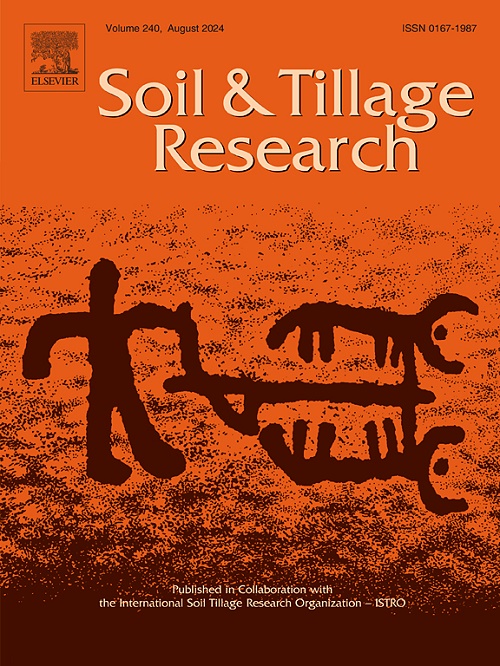全球草原区土地利用转换过程中细菌和真菌多样性的耦合受扰动强度的限制
IF 6.1
1区 农林科学
Q1 SOIL SCIENCE
引用次数: 0
摘要
草地细菌和真菌群落动态受到土地利用转换的强烈影响,但其大规模多样性响应尚不清楚。我们利用94份出版物中的422份观测数据,量化了草地土地利用转换(即天然草地转化为农田、森林或人工草地)对土壤微生物α多样性(Chao1丰富度和Shannon多样性)的影响。总体而言,草地利用转换显著降低了真菌Shannon多样性(5.1% %),而略微增加了细菌Shannon多样性(2.0 %)和Chao1丰富度(6.0 %)。这些影响是由与高扰动相关的转换类型(即向农田或森林的转换)以及耕作或演替管理驱动的。细菌和真菌对Chao1丰富度的响应在土地利用转换下呈正耦合,在农田生态系统和耕作管理下呈解耦。细菌和真菌的Shannon多样性的正耦合不具有统计学意义,直到与转换相关的扰动收敛到较低水平:当土地利用转换引起的细菌多样性变化在±30 %以内时。这种耦合受土壤养分有效性(硝态氮和有效磷)的调控。我们的研究结果强调了细菌和真菌多样性对草地土地利用转换的有限和耦合响应,以受扰动强度调节的方式。应谨慎地进行土地利用转换和管理,以保护草原区的生物多样性和土壤功能潜力。本文章由计算机程序翻译,如有差异,请以英文原文为准。
The coupling of bacterial and fungal diversity under land-use conversion in global grassland regions is limited by perturbation intensity
The dynamics of bacterial and fungal communities in grasslands are strongly affected by land-use conversion, but their large-scale diversity responses remain unclear. We quantified the effects of grassland-use conversion (i.e., native grassland converted to cropland, forest, or artificial grassland) on soil microbial alpha diversity (Chao1 richness and Shannon diversity) using 422 observations from 94 publications. Overall, grassland-use conversion significantly reduced fungal Shannon diversity (5.1 %), whereas it marginally increased bacterial Shannon diversity (2.0 %) and Chao1 richness (6.0 %). These effects were driven by conversion types associated with high perturbation, namely conversion to cropland or forest, and by cultivation or succession management. The responses of bacterial and fungal Chao1 richness were positively coupled under land-use conversion but decoupled in cropland ecosystems and under cultivation management. The positive coupling of bacterial and fungal Shannon diversity was not statistically significant until the perturbation associated with conversion converged at a lower level: when the bacterial diversity change induced by land-use conversion was within ± 30 %. This coupling was regulated by nutrient availability in soil (nitrate and available phosphorus). Our findings highlight the limited and coupled responses of bacterial and fungal diversity to grassland-use conversion, in a manner regulated by perturbation intensity. Land-use conversion and management should be undertaken cautiously with the goals of conserving biodiversity and soil function potential in grassland regions.
求助全文
通过发布文献求助,成功后即可免费获取论文全文。
去求助
来源期刊

Soil & Tillage Research
农林科学-土壤科学
CiteScore
13.00
自引率
6.20%
发文量
266
审稿时长
5 months
期刊介绍:
Soil & Tillage Research examines the physical, chemical and biological changes in the soil caused by tillage and field traffic. Manuscripts will be considered on aspects of soil science, physics, technology, mechanization and applied engineering for a sustainable balance among productivity, environmental quality and profitability. The following are examples of suitable topics within the scope of the journal of Soil and Tillage Research:
The agricultural and biosystems engineering associated with tillage (including no-tillage, reduced-tillage and direct drilling), irrigation and drainage, crops and crop rotations, fertilization, rehabilitation of mine spoils and processes used to modify soils. Soil change effects on establishment and yield of crops, growth of plants and roots, structure and erosion of soil, cycling of carbon and nutrients, greenhouse gas emissions, leaching, runoff and other processes that affect environmental quality. Characterization or modeling of tillage and field traffic responses, soil, climate, or topographic effects, soil deformation processes, tillage tools, traction devices, energy requirements, economics, surface and subsurface water quality effects, tillage effects on weed, pest and disease control, and their interactions.
 求助内容:
求助内容: 应助结果提醒方式:
应助结果提醒方式:


